Take a Trip Through the Witty, Wicked Imagination of Artist Patrick Oliphant
From a watercolor of President H. W. Bush depicted as Mary Poppins to President Barack Obama drawn and sculpted as …
From a watercolor of President H. W. Bush depicted as Mary Poppins to President Barack Obama drawn and sculpted as an Easter Island statue, visitors see the range of political cartoonist Patrick Oliphant’s work in the first tour of his voluminous archive in the University of Virginia’s Albert and Shirley Small Special Collections Library.
Last year, Oliphant donated almost 7,000 drawings, watercolors, prints, sculptures and sketchbooks to the UVA Library. Complementing his exquisite art is a wealth of archival material: some of the scrapbooks in which he began his work every morning, plus correspondence, photographs, professional papers and recordings.
The exhibition, “Oliphant: Unpacking the Archive,” opened this week and will remain on display in the Harrison/Small building’s main gallery until May 30.
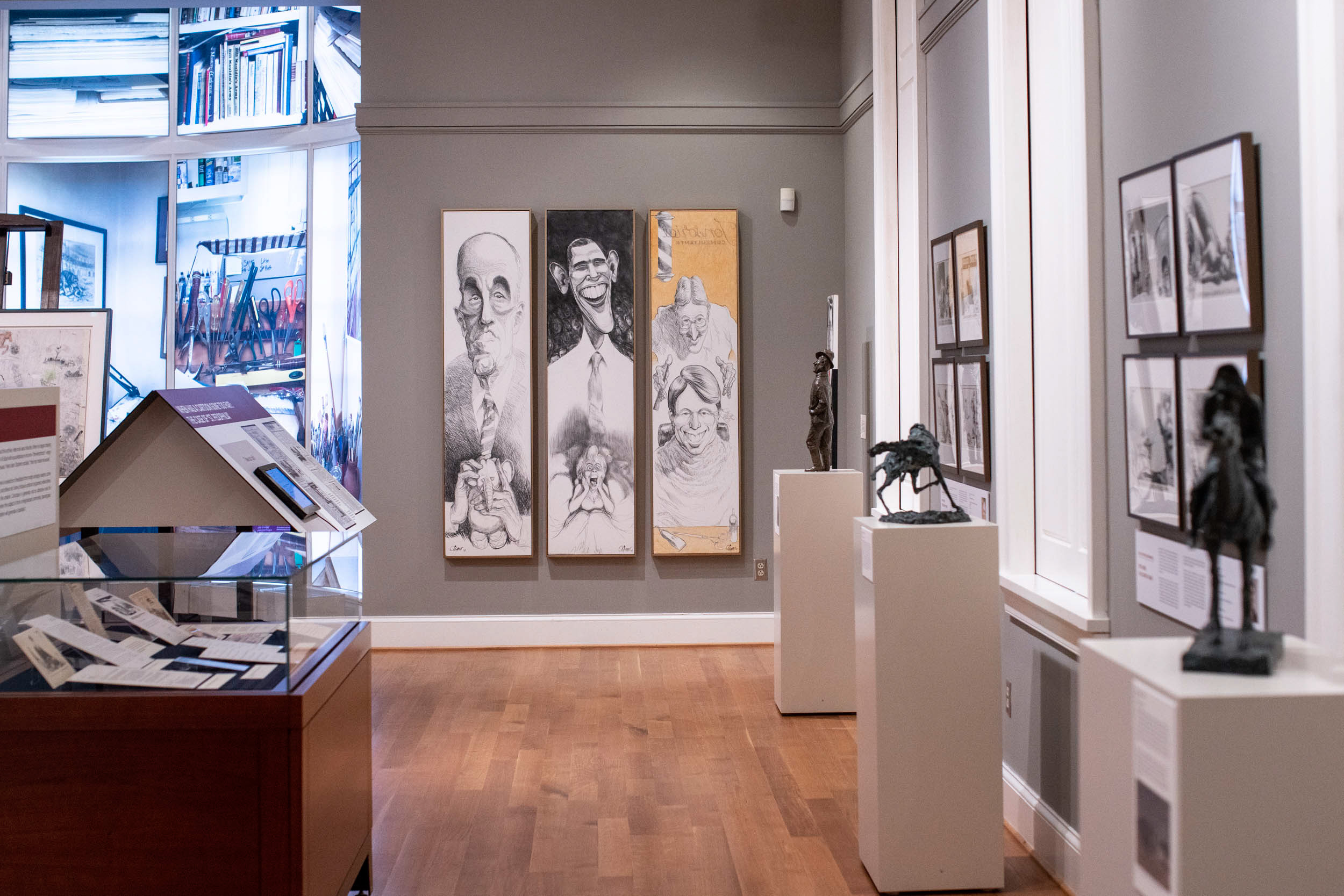 The exhibit marks a collection of his work that’s never been seen like this before, especially juxtaposing items from his cartoon archive with pieces of art,” library curator Molly Schwartzburg said.
The exhibit marks a collection of his work that’s never been seen like this before, especially juxtaposing items from his cartoon archive with pieces of art,” library curator Molly Schwartzburg said.
“It was like a time machine,” when seeing more than five decades of work, said one of the exhibit’s co-curators, Elizabeth “Beth” Hutton Turner, University Professor of Art History.
This exhibition celebrates the library’s recent acquisition and shows how and why Oliphant became the most widely syndicated, most influential political cartoonist in America.
Panels covering the gallery’s bay window are made of a type of screen that blocks direct sunlight and can have photos reproduced on them. For this exhibit, the panels’ screens recreate his studio at home with photos taken last year. In front of them stands the only piece on loan from Oliphant (rather than part of the donated archive): one of his drawing boards, which shows his imagination at play.
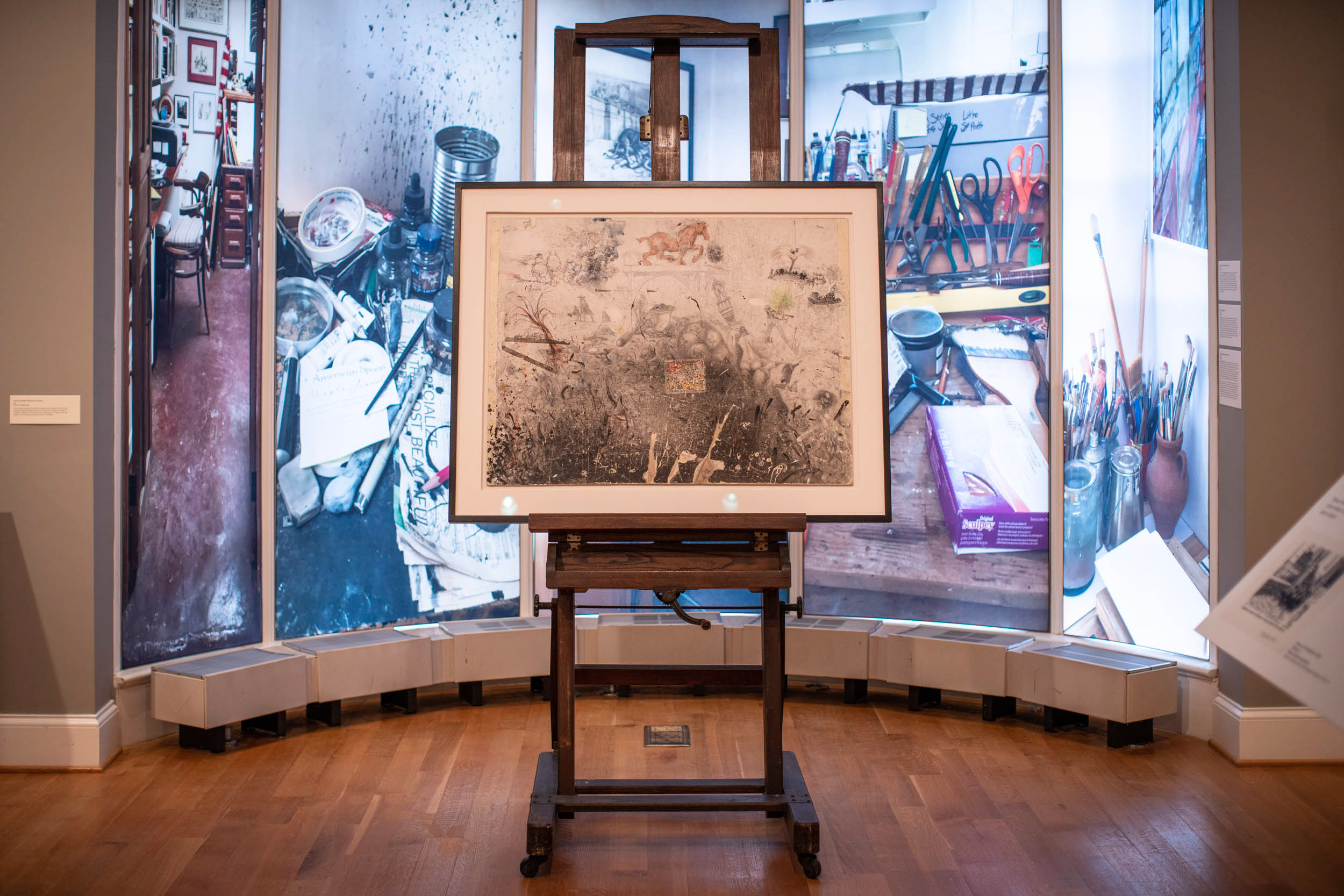 In front of the panels that show Oliphant’s studio stands the only piece on loan from him: one of his drawing boards, which shows his imagination at play.
In front of the panels that show Oliphant’s studio stands the only piece on loan from him: one of his drawing boards, which shows his imagination at play.
“The exhibit marks a collection of his work that’s never been seen like this before, especially juxtaposing items from his cartoon archive with pieces of art,” library curator Molly Schwartzburg said. In the multi-disciplinary nature of Oliphant’s practice – where even his cartoons are works of art – viewers can follow his stellar career, she said. They might not realize he also exceled in the fine art media of sculpture and watercolors, transcending the limits of cartoon drawing.
Oliphant and his wife, Susan Conway Oliphant, visited the University from their home in Santa Fe, New Mexico, to see the opening of the exhibit on Monday. As a conservator and gallery owner, Susan had meticulously archived and organized his work for decades. The couple met in 1988 when she started representing his work, and were married in 1996.
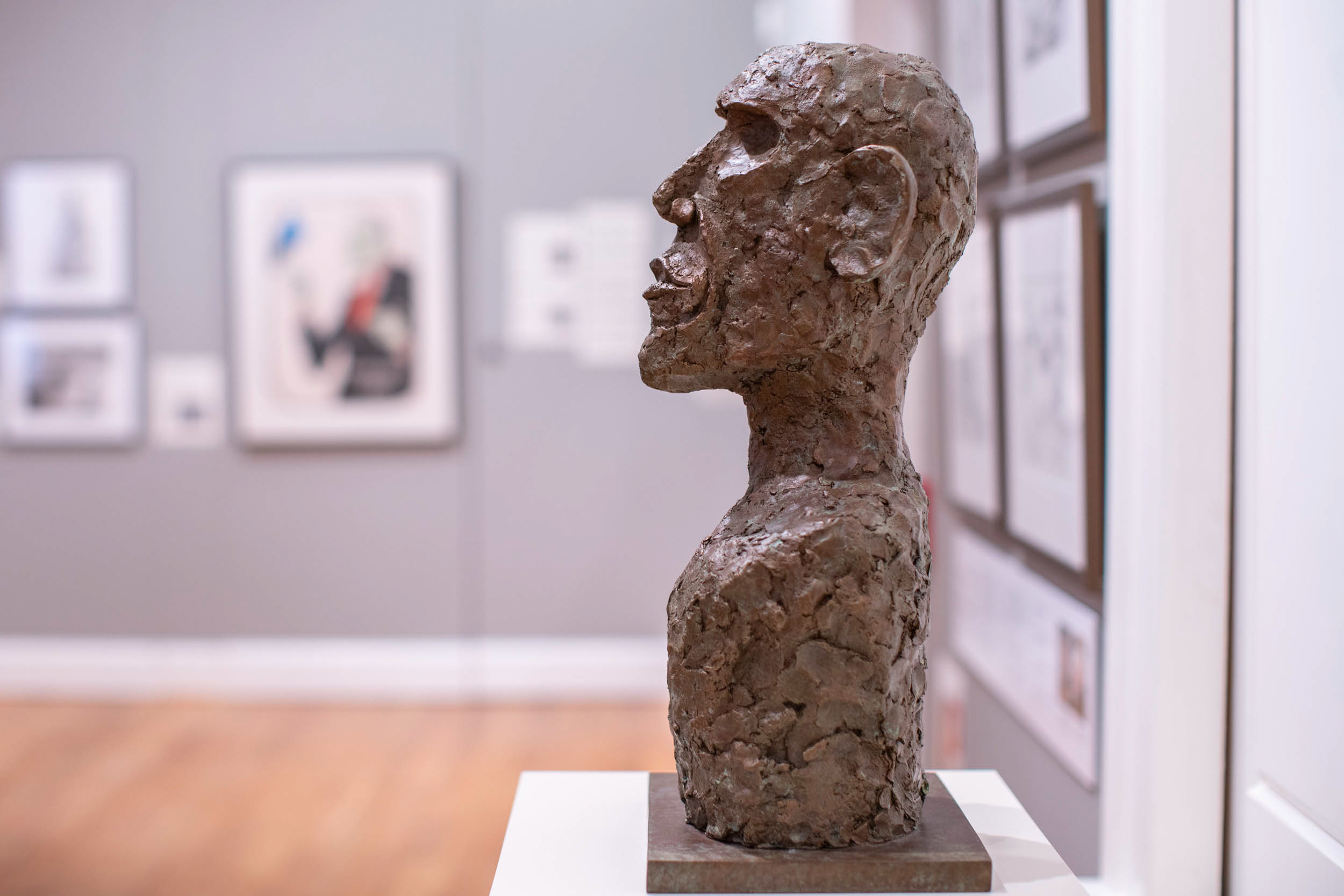 During Obama’s first year as president, Oliphant translated his cartoon of Obama as an Easter Island figure into a bronze bust.
During Obama’s first year as president, Oliphant translated his cartoon of Obama as an Easter Island figure into a bronze bust.
“It’s beautifully done. I can’t think of a time when I’ve seen my work better displayed,” said the 93-year-old artist, who fully retired from political cartooning just five years ago after reducing his daily output in 1995. His career spanned nine presidents, from Lyndon Johnson to Barack Obama.
He’s actually relieved, he said, not having to draw the current president regularly. As witty as ever, he said, “It would’ve been horrible, an embarrassment of riches. I wouldn’t know where to start.”
Oliphant gave some advice to young would-be political cartoonists: Hone your observation skills and watch for the characteristics that lend themselves to caricature. “Approach everything with humor,” he said. He was always reading the news and history, Susan said.
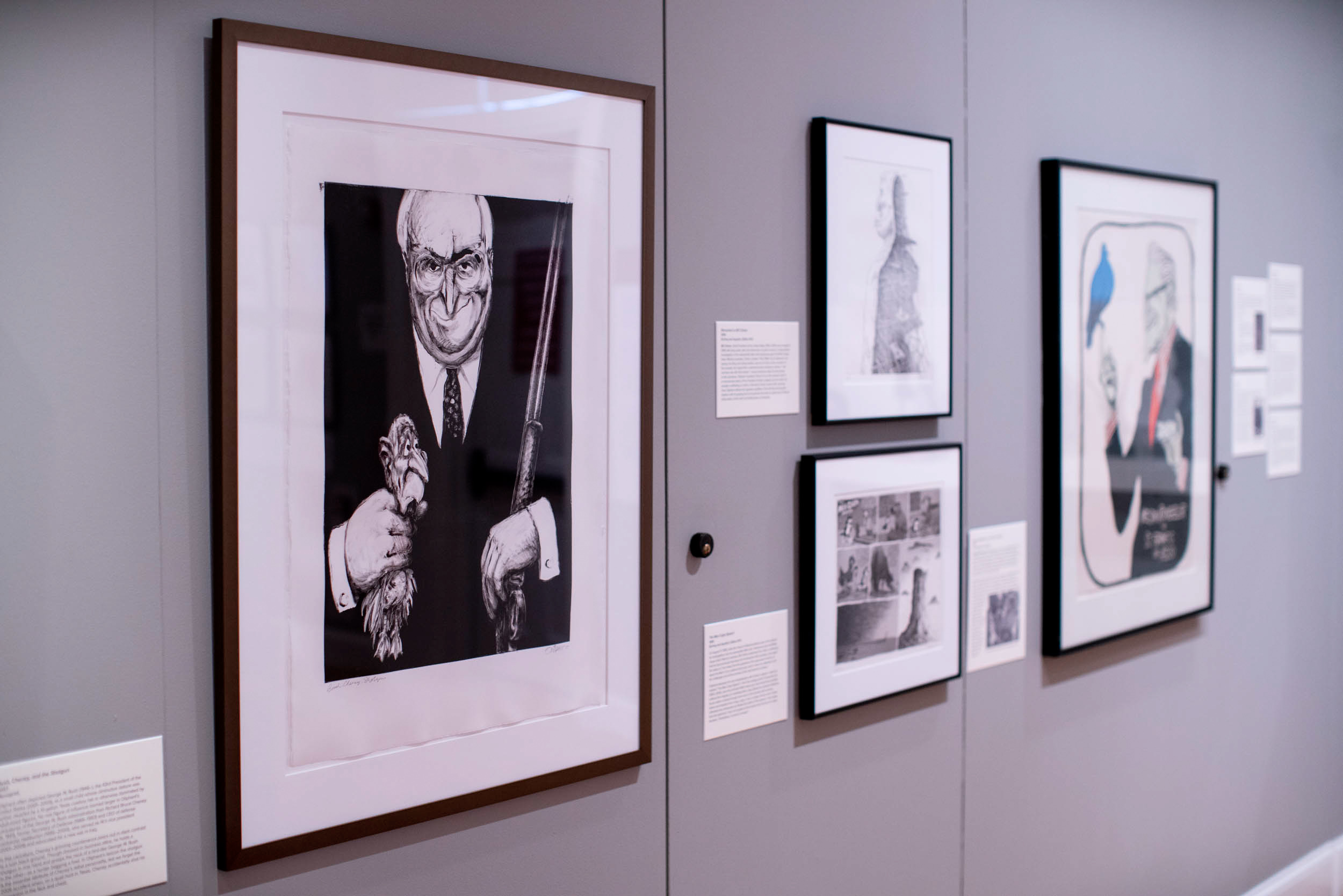 Oliphant, whose career spanned nine presidents, caricatured other political candidates and leaders, including Vice President Dick Cheney, left.
Oliphant, whose career spanned nine presidents, caricatured other political candidates and leaders, including Vice President Dick Cheney, left.
With the decline of printed newspapers, he said he hopes today’s generation finds a way to keep the genre alive.
He enjoyed surprising himself every day for 60 years, he said.
About his daily output, his wife said, “Keep in mind, from sketchbook to drawing, first he worked it out in pencil [with accompanying text as well as image] and then he went to his desk and with ink and pen or quill; he drew that day’s work by noon. Then he’d scan it and send it to the syndication office. … The mornings were intense.”
That was just during the most recent years since computer technology made it possible. Before the mid-1990s, he’d have his daily cartoon picked up and delivered.
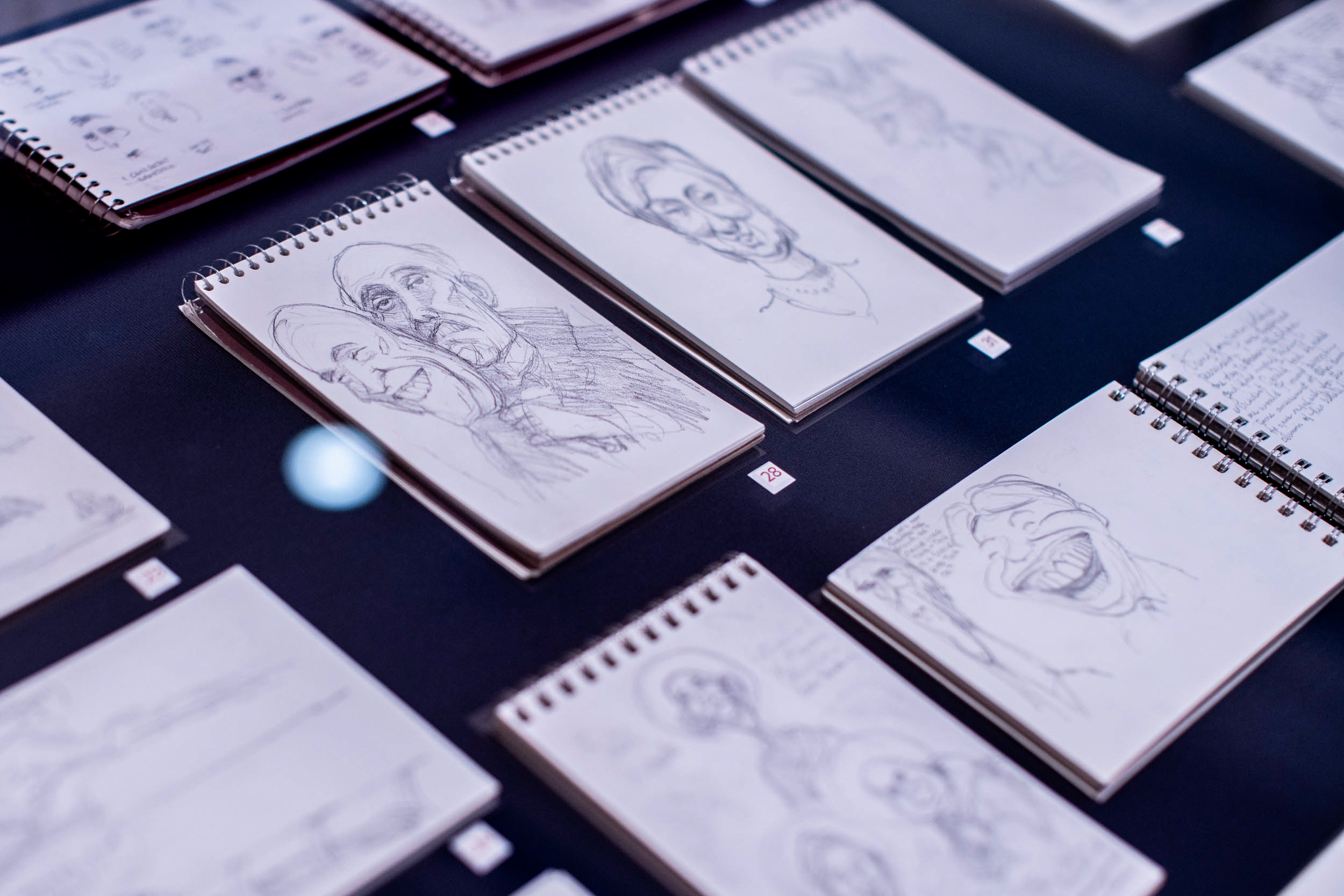 Oliphant used small sketchbooks to work on his daily cartoons.
Oliphant used small sketchbooks to work on his daily cartoons.
With cases of sketchbooks on display, visitors can see the genesis of Oliphant’s ideas. The sketchbooks show the range of his work, including how he developed his caricatures. Turner compared Oliphant’s caricatures to the characters drawn with words in Charles Dickens’ novels.
Looking from sketchbook to finished image, Schwartzburg said, “You can get an idea of his process and insight, and a full sense of his art’s meaning.”
The exhibit opening also featured a special program on Tuesday at the Miller Center, “Cartooning the White House: Celebrating Comic Artist Patrick Oliphant,” that treated a packed audience in Newcomb Hall Theater to two panels – one with historians and the second with practitioners, who reflected on a set of era-relevant Oliphant cartoons.
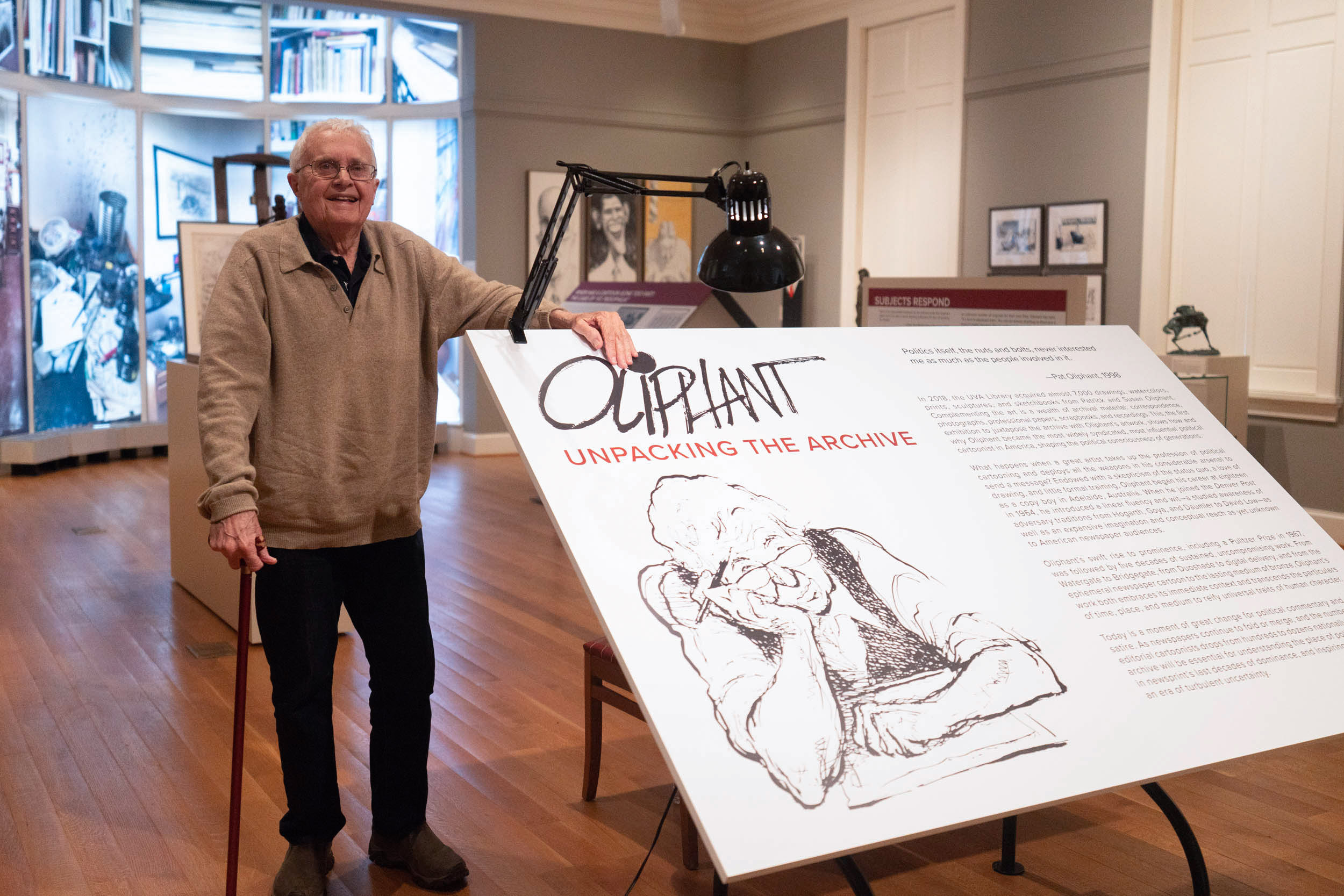 Oliphant emigrated from Australia to the U.S. in 1964 to enjoy the ideals of free speech in the newspaper industry and worked here for about 50 years.
Oliphant emigrated from Australia to the U.S. in 1964 to enjoy the ideals of free speech in the newspaper industry and worked here for about 50 years.
Turner said Patrick and Susan Oliphant had a positive experience at UVA 10 years ago when they came for an exhibit and program at the Miller Center. At that time, he gave talk-and-draw presentations.
When thinking of an institution that could “bear the weight” of his work, the Miller Center’s study of the presidency and the Special Collections Library’s ability to house and create access to the work made it an attractive repository.
“There’s great potential for research with an archive of this substance being here at UVA,” Turner said. “UVA can make the process of inquiry into Oliphant’s world transparent, including his art and archive.”
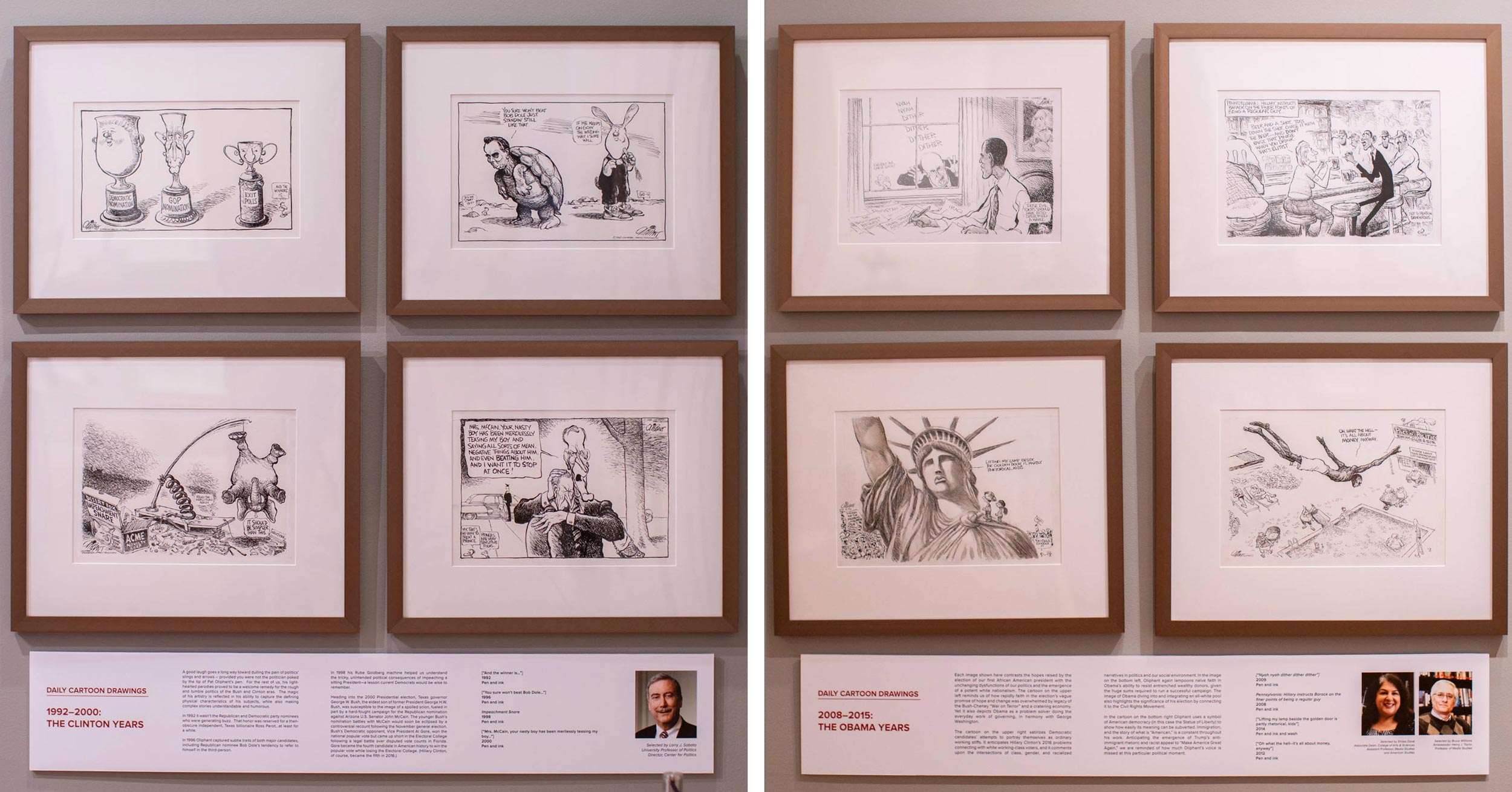 Politics professor Larry Sabato chose four cartoons from the Clinton era; media studies professors Shilpa Davé and Bruce Williams chose four from the Obama years.
Politics professor Larry Sabato chose four cartoons from the Clinton era; media studies professors Shilpa Davé and Bruce Williams chose four from the Obama years.
To that end, the exhibit’s curators invited six faculty members, chosen for their teaching and research strengths, to pick four cartoons from a particular presidential era and write a short commentary about them. Next semester, six other faculty members will pick other groups of four cartoons.
Douglas Fordham, associate professor of art history, chose four cartoons from the Richard Nixon years, 1969 to 1974; Carmenita Higginbotham, also an associate professor of art history, chose from the Carter administration, 1975 to 1980; Craig Shirley, a visiting scholar in the Batten School of Public Policy well-known for his four books on Ronald Reagan, picked four from Reagan’s eight years, 1980 to 1988; University Professor of Politics Larry J. Sabato, covered the Clinton years, 1992 to 2000; and Shilpa Davé, assistant professor in media studies and American studies, collaborated with Bruce Williams, Ambassador Henry J. Taylor Professor of Media Studies, to pick four cartoons each from the George W. Bush years, 2000 to 2008, and from the Obama years, 2008 to 2016.
Anne E. Bromley
University News Associate
Office of University Communications
Original Publication: UVA Today
You are using an old version of Internet Explorer. Our site is developed with the latest technology, which is not supported by older browsers
We recommend that you use Google Chrome for accessing our (or any) website. It is a FREE and modern web-browser which supports the latest web technologies offering you a cleaner and more secure browsing experience.